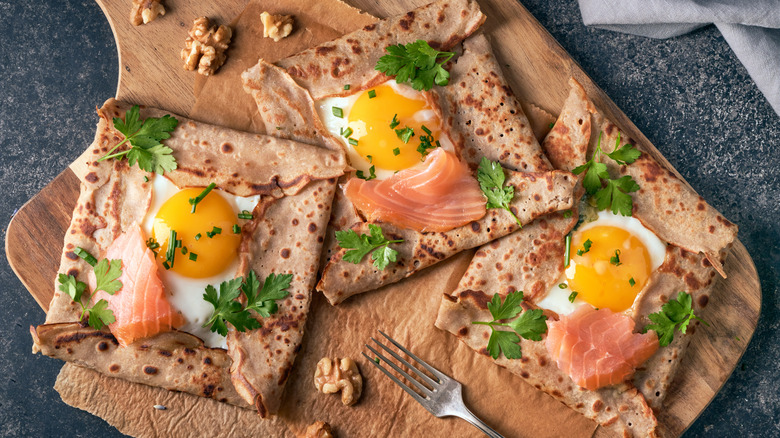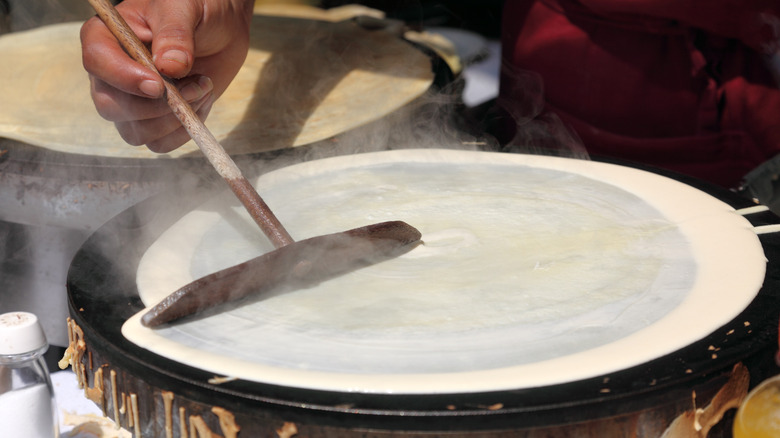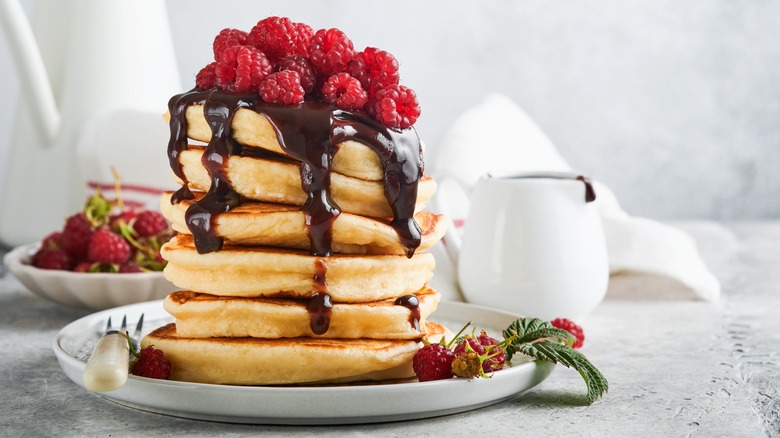The Difference Between Crepes And Pancakes, Explained
You may think there's nothing more satisfying than a stack of pancakes cooked to perfection and doused with hot maple syrup on a Sunday morning. But have you tried a French crepe? Though it can be easy to confuse these two batter-based, doughy confections, there are some key distinctions. The main difference is that pancakes require a leavening agent (commonly baking powder or soda) to get their signature fluffy nature and rise as they bake on a hot, buttered griddle, while crepes are thin and flat.
It's true; you could technically call a crepe a pancake (and they do fall alongside the likes of pancake-type formats globally, including South Indian dosa pancakes and Korean scallion pancakes). Compared to American flapjacks, however, crepes are significantly thinner (like paper thin) and often contain crisped lacy edges around the circumference. Though they are round like pancakes, which come in various sizes (including the recently popularized tiny pancake cereal bites), crepes are typically made into larger circles by pouring a thin layer of batter on a well-buttered round cooking surface called a billig. The batter is then spread out into a thin layer. Once cooked through and flipped to golden brown, unlike pancakes, which are stacked and dolloped with toppings, crepes are filled with ingredients like fresh fruit with chocolate, or cheeses, jams, and meat. They are then folded up to make a treat, which can be eaten with a fork or in a hand-held fashion, similar to a sandwich.
Crepes are uniquely French, and can be sweet or savory
Crepes, which originated in Brittany, France, around the 13th century, were first made with buckwheat flour cultivated in the region. Comparatively, thicker pancakes, which have been eaten in various forms for centuries, were popularized in the states in the late 1800s and experienced a resurgence in the 1930s with the invention of Bisquick. Today, crepes, like pancakes, can be made with various flour types, including but not limited to buckwheat — you can even find chickpea flour crepes, called socca, in some parts of France.
The ingredients required to make crepe vs. pancake batter are similar: flour, sugar, salt, butter, and water or milk. However, crepes are always made sans leavening agents to achieve their flatness. Though pancake and crepe batter don't contain loads of sugar (usually just a tablespoon or two per batch), pancakes are often topped exclusively with sugary toppings like maple syrup, jam, berries, and whipped cream.
While crepes are also popular for their inclusion of sweets, such as thinly sliced fresh strawberries, and chocolate or Nutella spread, you'll find these ingredients embedded inside the crepe or drizzled on top rather than baked in. Crepe batter is usually kept quite simple. The fillings provide a symphony of flavors in every bite — including savory variations, which are equally popular as sweet. With popular fillings like brie, prosciutto, fig jam, ham, and Swiss, crepes make a perfectly filling snack or meal.
Both pancakes and crepes lend themselves to creativity
Some say crepes are more versatile, and they very well might be. While pancakes in the U.S. are traditionally eaten for breakfast, slathered with butter and syrup, knife and fork required, you can enjoy a crepe pretty much anytime and with relative ease — from street food to fine dining. Rolled or folded with a variety of fillings, you can eat a crepe on the go or make more involved variations such as a crepe-stacked cake. To get really fancy, try your hand at crepes Suzette, or better yet, order it at a French restaurant, where they'll flambé crepes in a mix of butter, orange juice, and liquor.
That's not to say you can't get creative with your typical pancake recipe. Add flavorings to pancake batter, and stud your pancakes with blueberries, chocolate chips, or sprinkles for a pop of intrigue. Mix in lemon juice and ricotta cheese for something a bit more tangy and savory. You can even make pancakes with protein powder for a heartier meal or play around with fun shapes deposited right onto the griddle. And, of course, you can jazz your favorite pancake recipe up by topping it with berry compote and fresh herbs like mint. Since pancakes are enjoyed stacked high, the type (and amount) of toppings are up to your discretion. Whichever you choose to enjoy — a French crepe or classic American pancake — know that both have earned their place culinarily.


